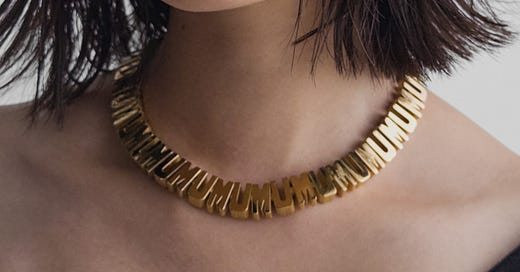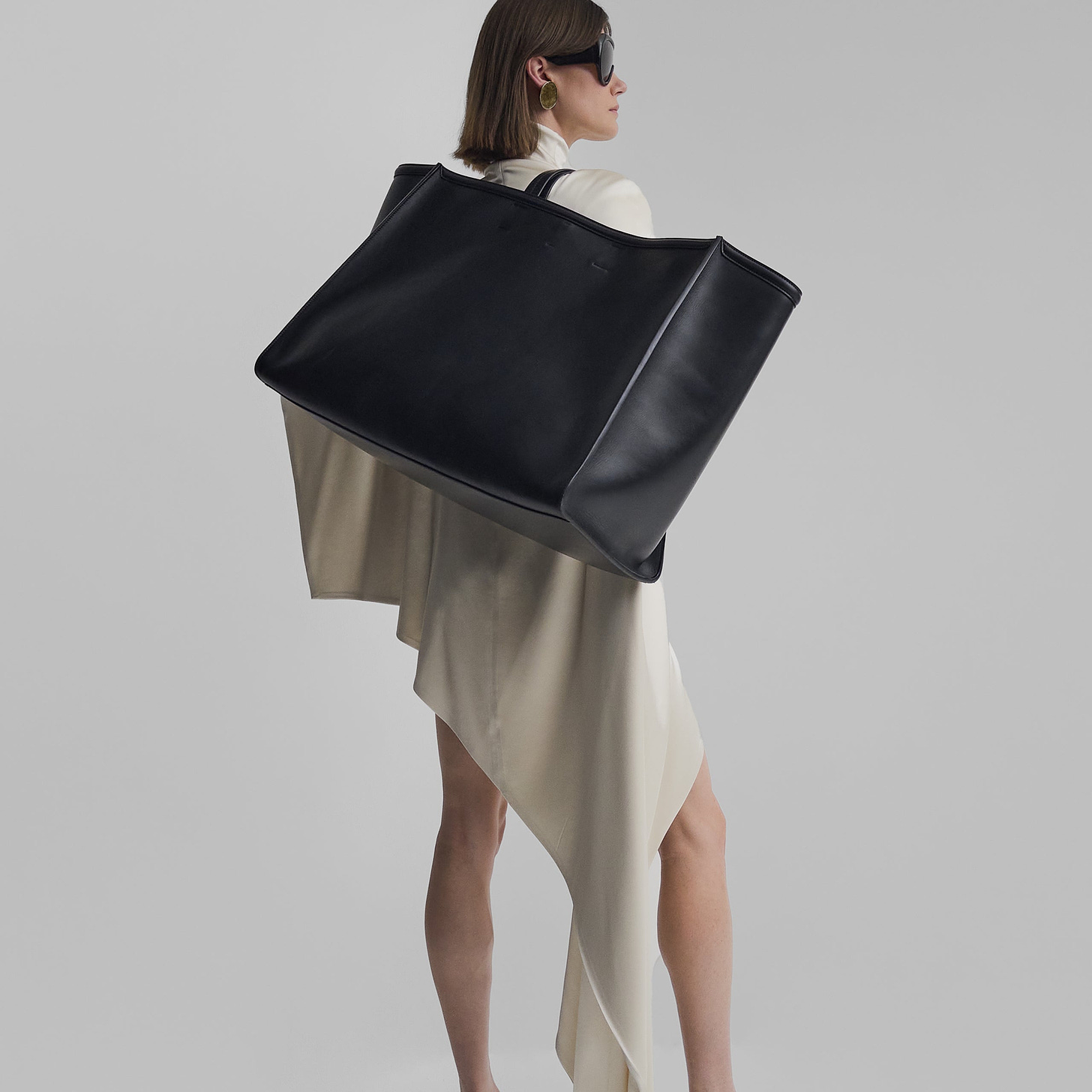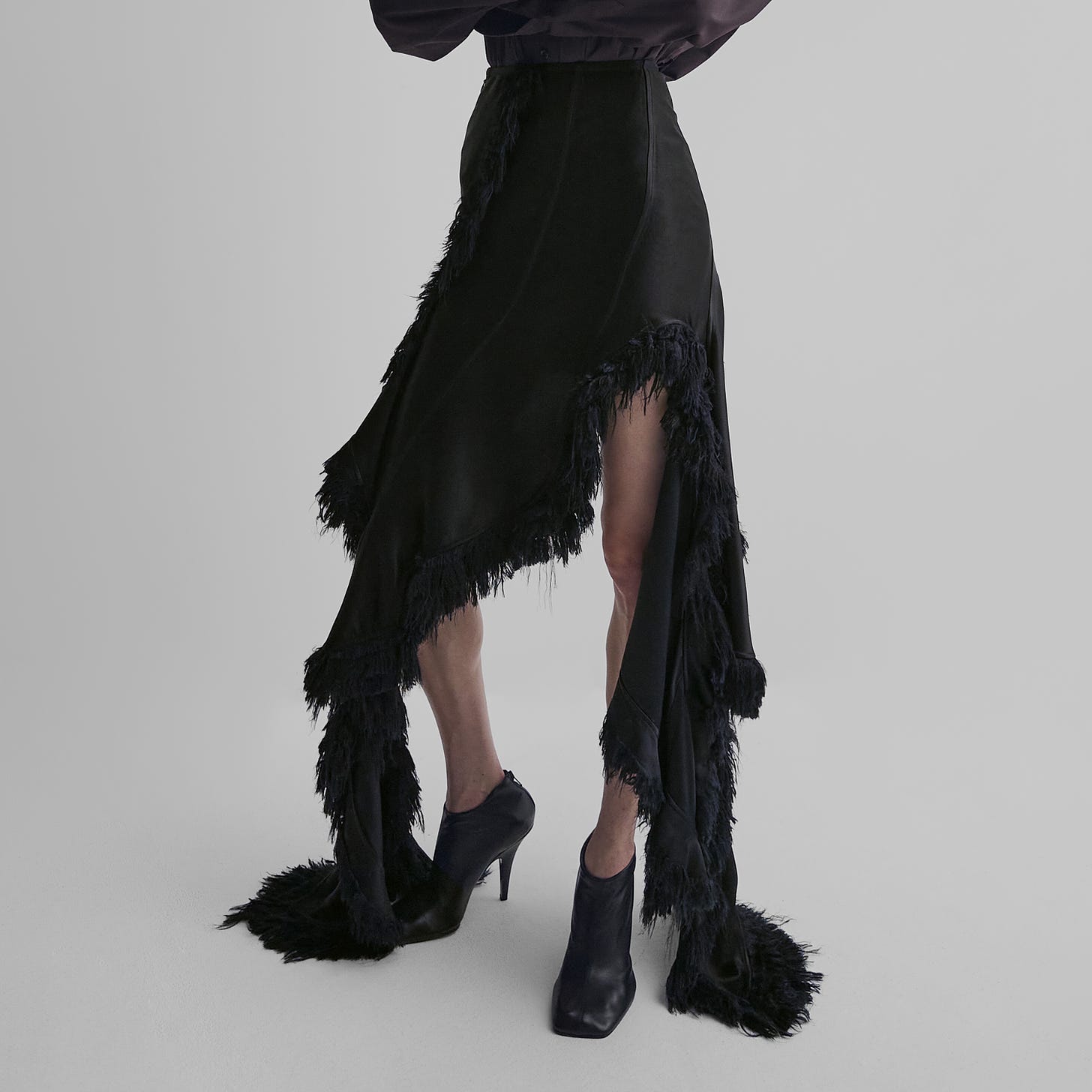Heads Explode Over Phoebe Philo's Prices
"Love that people will be dishing out thousands of dollars to look like a ceramicist married to a hedge fund manager."
“I wanna know who spent that much on plated garbage?” said TikToker @ShayinJune in a video about Phoebe Philo’s new collection, which dropped online Monday. Her caption: “Can we talk about the $3000 MUM necklace 💀??? did I like the collection, yes…was it groundbreaking enough to warrant the PRICE, I dont think so.” Here’s the necklace, which has sold out:
TikToker Charles Gross, who is known in part for his Birkin collection, raised an eyebrow at the oversized $8,500 leather tote, noting that that was an introductory Hermès price.
A number of citizen reviewers called the bags out for lacking hardware, including feet (so, you know, look out for floors), and, like so many things in life, closure.
While Hermès is a heritage brand founded in 1837 that you could argue has earned its astronomical pricing over nearly two centuries, the Phoebe Philo brand is days old. That said, her eye-watering prices seem in line with the currently bonkers luxury market. For instance, her sequined “T-shirt dress,” at $19,000, is still cheaper than this $21,000 “viscose flag dress” by Burberry.
Philo’s turtleneck sweater with the extra-long sleeves went for $1,100 (it’s sold out), which is less than every single Prada sweater available for purchase on Saks.com right now. I couldn’t find a cookie-cutter copy in merino wool, but a short ribbed knit turtleneck with a leather Prada logo and two gold buttons on the shoulder retails for $2,150.
Critiques of Philo’s prices have been widespread on social media in the wake of the debut of the collection, called “A1.” Back Row subscribers had a super-entertaining discussion about it (the best on the internet, I’d argue) in our chat, much of it also pertaining to the prices. “The $1100 polyamide leggings make no sense though. Why so expensive?” commented
. “Something about seeing the price of those leggings really flipped the switch for me. Love that people will be dishing out thousands of dollars to look like a ceramicist married to a hedge fund manager.” agreed, saying, “[T]here is a bit of undercover delight and outright outrage... I vacillate between those two emotions. I am sure I am too amateur to see the value and beauty in the items... at that price 🤷🏾♀️.”Don’t get me wrong — I find these prices and those of other luxury fashion brands to be wild. But Philo has led design for Chloé and Celine — both pretentious luxury houses — so there was little reason to expect her to come out the gate with something in the vein of, I don’t know, KHY by Kylie Jenner. Plus, she occupies a unique position in fashion as a designer with a truly dedicated fandom: Beyoncé has the beyhive, Lady Gaga has little monsters, Philo has “Philophiles.” And these aren’t just Instagram enthusiasts. These fans actually buy her stuff. Pieces from her Celine collections, which she designed from 2008 til 2017, have become highly coveted collectibles known today as “Old Celine.” And she has been absent from fashion design since she left that brand, meaning her fans haven’t gotten a Philo fix (“phix” if we want to be annoying about it) in six years.
So Philo had unique momentum going into her launch, which consisted of basically just putting the stuff online (highly select fashion people, like The Cut critic Cathy Horyn, got a secret in-person preview). The runway slideshow of the collection posted to fashion sites like Vogue.com is the same as what consumers are shopping from. She didn’t stage a show in an exotic location halfway around the world or invite Kim Kardashian or even give any interviews to press. It felt like fashion to discover instead of fashion to unwillingly absorb.
The clothes are minimal and upscale in the vein of what Philo is known for. Much of it was wearable, though I wish the fashion press would admit that stuff like this $3,000 sold-out skirt that drags on the ground with heels is not actually easy to wear:
The pants with the zippers up the back of the legs were nearly universally praised in reviews, but Back Row commenter
said, “I am NOT sitting on zippers.” Not that I can afford them (unless the rest of you free subscribers want to go paid or buy one of my books) but neither am I. Respectfully to the New York Times’s Vanessa Friedman, who asked, “Will anybody unzip them all the way? Wouldn’t you like to try it and see?” — no.But the minimalism Philo popularized, which so many brands started to copy during her Celine tenure, seems set to become the look of the decade. You can get this kind of thing from Bottega Veneta, The Row, Proenza Schouler, Khaite, and more labels, which makes Philo’s vision less distinct than it once was. “I am wondering if she'll be victim of the aesthetic she propelled,” commented
, who added, “I am confident the people who are her fans will buy her brand.”Some commenters pointed out that the collection was conceived for skinny people, which is such a tired, disappointing approach. “Listen, I think the new brand is beautiful. It’s exactly what we all want to wear. But it’s not something anyone in a middle-class or even upper-middle-class income bracket can afford. And it’s not a collection anyone over a size 10 can wear. So while I love her and love her clothes, I’m not sure how celebratory I can be about a collection that I and most people I know can’t partake in,” commented
. The trousers, which were treated like the second coming of pants themselves in the fashion community, top out at size FR 44 or a US 12 (and that’s if they don’t run small as so many European brands do).Philo has also received renewed criticism for lack of diversity in her casting. A clip of Iman saying she never bought one of Philo’s Celine bags after Philo asked her if she would be forced to cast black models has been making the rounds on Reddit. In 2013, model and activist Bethann Hardison told the Standard, “Phoebe Philo — she’s a cool girl. But Céline has never had a coloured person showing in their collection. Ever.”
The new line is backed by LVMH and the approach reminds me a bit of Tom Ford’s namesake line, which he co-founded in 2005. He held off on fashion shows for a while, and his clothing was always exorbitantly priced. He had, like Philo, a reputation for being special going into that launch. His Gucci pieces were then, as they are now, coveted among his fans. (The fashion press seems to have missed the opportunity to come up with a cutesy name for that group of people.) When he opened a store in Manhattan in 2007, off-the-rack suits started at $3,000 (about $4,500 adjusting for inflation), and the sunglasses — also the cheapest item in Philo’s line at $750 — cost $450 ($675 today, adjusting for inflation). One dinner jacket was $5,960, or around $8,500 today.
People buy Tom Ford because the stuff cost that much. The brand is a status symbol. Yes, Ford offered as lavish a retail environment as possible. (As Horacio Silva wrote in his NYT review, “…if I am going to pay $5,690 for a dinner jacket, I want to try it on and have someone fawn over me while I do so.”) But the items weren’t expensive because that’s what they cost to make. As Timo Rissanen, then-associate dean at Parsons School of Design and a professor of fashion design and sustainability, told Chavie Lieber in a 2016 Vox story about why luxury brands destroy unsold merchandise, “The retail price of a luxury product has nothing to do with its actual value. When you buy something from Chanel or Gucci and you pay full retail, that money is actually paying for the massive advertising campaigns. If Chanel destroys a dress it tried to sell for $1,200, it hasn’t really lost $1,200. I don’t think Chanel even paid $100 [to make] that dress. And the money they’d lose would probably just be recouped through fragrances.” But anyone who has watched Tanner Leatherstein destroy a designer bag in order to ascertain the cost of making it on social media already knows this.
Philo’s new line is nearly sold out at the time of this writing. A brand “factsheet” distributed to press said item quantities would be “notably less than anticipated want,” and that the scarcity was “a responsible balance between production and demand.” While I’ve seen this called “sustainable,” it’s utterly ridiculous to call a new fashion brand that requires resources to create and ship sustainable. This is about scarcity, which is a marketing tactic.
In recent months, we’ve seen spending on aspirational luxury contract, while Hermès — which sits at the highest end of the market — has actually seen sales grow more than its competitors. Whether you love what she does or not, Philo seems as well-positioned as anyone can be to become the next bizarrely resilient, ridiculously expensive fashion brand.
Back Row is a reader-funded publication. To support the independent journalism you read here, consider becoming a free or paid subscriber.










Why did I think the necklace said MuMu though 😂
The chat created about Phoebe Philo was and still is fire, I keep coming back to it each time there is a new comment. It is eye-opening to see the variety of opinions with people making valid and smart commentary. The fashion industry and media want us to believe customers, people interested in fashion and even fashion professionals don't have an opinion because, after all, it is an industry favouring the glorification of fashion designers and the people at top positions (sometimes it eerily feels cult-like) but I am glad to read people proving it is the opposite. Ah and by opinion, I mean having a critical mind where they're able to see the pros and the cons, something that has been lacking for a while on the internet, but not only.